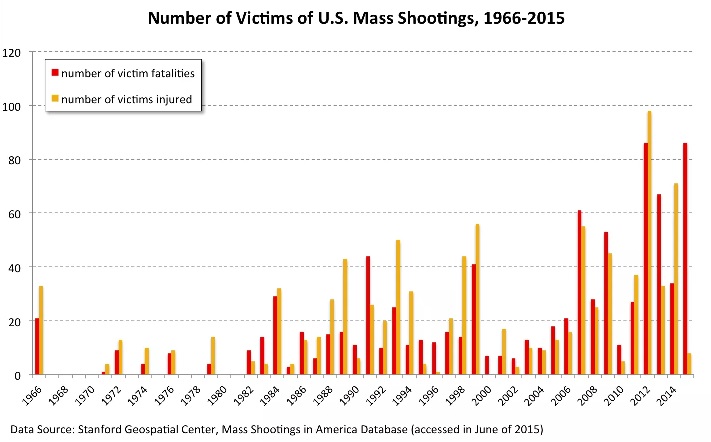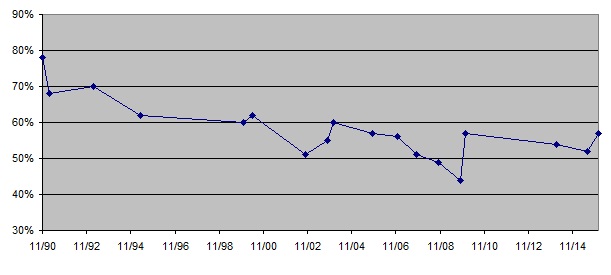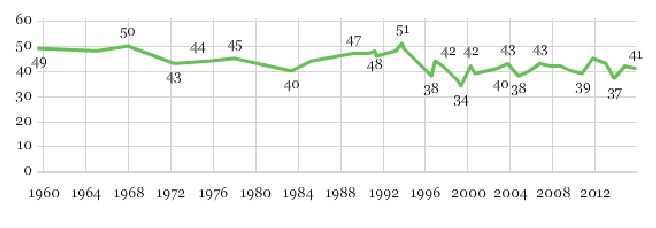|
What are the latest developments in the U.S. gun control controversy?
The gun control controversy has resurfaced in the aftermath of incidents of highly publicized indiscriminate deadly mass shootings. Many of these shootings have involved the use of automatic weapons. Such incidents were extremely rare prior to the mid 1980s but have become alarmingly frequent since then.  The reasons for this epidemic are poorly understood. The reasons for this epidemic are poorly understood.
It remains to be seen whether renewed gun control fervor will continue since gun control has not been a politically popular issue in recent years. Fewer Americans are supportive of gun control in general  and handgun control in particular. and handgun control in particular.  While the issue has dropped in overall public concern, it remains what politicians consider a "wedge issue" as many opponents of gun control are passionate about their right to unfettered gun ownership and may make voting decisions on this issue alone. The percentage of
Americans who consider "gun control" as an important issue has been low until it again rose in the aftermath of these shootings. While the issue has dropped in overall public concern, it remains what politicians consider a "wedge issue" as many opponents of gun control are passionate about their right to unfettered gun ownership and may make voting decisions on this issue alone. The percentage of
Americans who consider "gun control" as an important issue has been low until it again rose in the aftermath of these shootings.
What is the present level of gun control in the United States?
Like many other aspects of public policy, gun control is a matter of federal, state and even local legislation. Under two Supreme Court rulings which were issued in 2008 and 2010, there are constitutional limits to gun control. Based on the second Amendment, these rulings invalidated laws in Washington D.C. and Chicago which had banned ownership of handguns.
Gun control has been an issue for many decades because of the fact that the gun death rate in the United States far exceeds the rate in other developed countries. 
- Federal Gun Control
The first major gun control initiative was enacted by Congress in 1934 which regulated the sale of fully automatic firearms like machine guns. This
legislation was followed in 1938 by a new federal law which required gun sellers to be licensed and which prohibited persons convicted of violent felonies
from purchasing guns. No further legislation was passed by Congress until 1968. The Gun Control Act of 1968 regulated imported guns, expanded gun-dealer
licensing requirements, and expanded the list of persons not eligible to purchase guns to include persons convicted of any non-business related felony,
minors, persons found to be mentally incompetent, and users of illegal drugs. In 1986, federal legislation established mandatory penalties for the use of a
gun in the commission of a federal crime. Also prohibited were "cop killer" bullets capable of penetrating bulletproof clothing. In 1990, legislation was
passed which banned the manufacturing and importation of semi-automatic assault weapons.
In 1994, Congress passed what has been regarded as the most comprehensive effort at national gun control. The "Brady Bill" named for the press aide who
was seriously injured in the assassination attempt on President Reagan imposed a five day waiting period for purchasers of handguns and required local law
enforcement authorities to conduct background checks of all purchasers. The Supreme Court held that the background check provision was unconstitutional
because it infringed on state's rights. Presently, the law has been revised so that the background check is instantly accomplished by gun dealers through a
national computer system and there is no longer a waiting period. Also in 1994, Congress passed a ban on certain types of assault weapons. This ban
expired in 2004. By a narrow margin  , the Senate voted to
extend the ban but the House did not take action and the ban was allowed to expire. Efforts to revive the ban have been unsuccessful. , the Senate voted to
extend the ban but the House did not take action and the ban was allowed to expire. Efforts to revive the ban have been unsuccessful.
How many guns are there?
According to an analysis by the Washington Post, by 2013 there were more guns than people in the United States, 357 million. Although it appears that the number of households owning guns has decreased  , there has been a substantial increase in amount of guns present in the households that have them , there has been a substantial increase in amount of guns present in the households that have them  . Slightly over a third of all guns are handguns. . Slightly over a third of all guns are handguns. 
How effective have gun control efforts been?
Gun control has clearly been unsuccessful in reducing the overall amount of guns. Although less than 1% of gun applications have been denied
since the enactment of the Brady bill, most of the denials have kept guns from felons.  But felons who want guns are able to use the secondary market in most states. Felons who live in a state that regulates the secondary market can easily use the secondary market in a neighboring state. But felons who want guns are able to use the secondary market in most states. Felons who live in a state that regulates the secondary market can easily use the secondary market in a neighboring state.
Guns are used in the majority of homicides  and because there there has been a reduction in the homicide rate since the 1990s and because there there has been a reduction in the homicide rate since the 1990s  , there has been a reduction in gun homicides. But the lower homicide rate is probably more associated with reduction of crime in general than with the institution of gun control. There is not a clear co-relation between homicide rate and the states that have more stringent gun regulation. , there has been a reduction in gun homicides. But the lower homicide rate is probably more associated with reduction of crime in general than with the institution of gun control. There is not a clear co-relation between homicide rate and the states that have more stringent gun regulation.  On the other hand, more gun deaths are the result of suicide than homicide On the other hand, more gun deaths are the result of suicide than homicide  and there is a very clear co-relation between the suicide rate and there is a very clear co-relation between the suicide rate  , the gun suicide rate , the gun suicide rate  and the percentage of suicides due to guns and the percentage of suicides due to guns  among the states with and without strong gun regulation. among the states with and without strong gun regulation.
How do other countries regulate guns?
Almost all major countries have systems for registration of firearms. Most major countries do permit the ownership of handguns. Many countries ban
ownership of certain types of weapons although some have no restrictions. The United States is the world leader in gun ownership and it has a correspondingly high homicide rate. But there is not a clear relationship between gun ownership and the homicide rate. Countries such as Canada have a significant degree of gun ownership yet a low rate of homicide. 
How do Democrats and Republicans differ on gun control?
Although Democrats tend to support gun control proposals and Republicans do not, the relative unimportance of the issue to most Americans has resulted in a paucity of successful gun control leglisation at any level in the past decade. Moreover, the opposition of gun proponents to all forms of gun control has remained fierce. Gun control opponents raise far more money than do gun control advocates.  In 1999 the Senate narrowly voted to regulate gun shows In 1999 the Senate narrowly voted to regulate gun shows  and more substantially supported a measure for trigger locks and more substantially supported a measure for trigger locks  but no action was taken by the House with respect to either proposal. In April 2004, the Senate again voted for handgun
locks but no action was taken by the House with respect to either proposal. In April 2004, the Senate again voted for handgun
locks  but the House did not consider the measure and the
issue has not recently been resurrected. but the House did not consider the measure and the
issue has not recently been resurrected.
More Information on Gun Control:
News Sites:
Current stories and links from Yahoo.com
Wikipedia-Gun Politics
Anti gun control sites:
Gun Owners of America
Gun Owners' Action League
National Rifle Association
Pro gun control sites:
Violence Policy Center
Brady Campaign to Prevent Gun Violence
|
Gun Control Charts
(click to enlarge)
Victims of Mass Shootings

Percentage of Americans Favoring Stricter Gun Control

Percentage of Americans Favoring Handgun Ban

Gun Death Rate in Selected Developed Countries

Extension of Assault Weapon Ban

Grading State Gun Laws

State Regulation of Secondary Market

Households Reporting Gun Ownership

Number of Guns Per Household

Types of Guns Owned

Reasons for Denial of Gun Purchase Applications By FBI

Type of Weapon Used in Homicides

U.S. Homicide Rate 1900-2015

Relationship Between Gun Homicide Rate and State Gun Control

Reasons for Gun Fatalities

Relationship Between Suicide Rate and State Gun Control

Relationship Between Gun Suicide Rate and State Gun Control

Relationship Between Percentage of Suicides by Gun and State Gun Control

International Rates of Gun Ownership and Homicide

Political Spending by Pro-Gun and Anti-Gun Supporters

Congressional Vote on the Brady Bill 1993

Senate Vote on Regulating Gun Shows

Senate Vote on Handgun Locks

|

